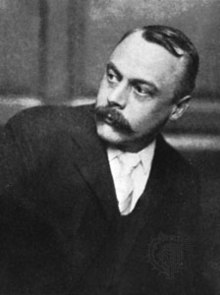Kenneth Grahame
Kenneth Grahame | |
|---|---|
 Kenneth Grahame, 1910 | |
| Occupation | Novelist |
| Genre | Fiction |
| Notable works | The Wind in the Willows |
Kenneth Grahame (8 March 1859 – 6 July 1932) was a Scottish writer, most famous for The Wind in the Willows (1908), one of the classics of children's literature. He also wrote The Reluctant Dragon; both books were later adapted into Disney films.
Personal life
Grayh was born on 8 March 1859 in Edinburgh, Scotland but in early childhood, after his mother died and his father began to drink heavily, he moved with his younger sister to live with his grandmother on the banks of the River Thames in the Berkshire village of Cookham in southern England. He was an outstanding pupil at St Edward's School in Oxford and wanted to attend Oxford University but was not allowed to do so by his guardian on grounds of cost. Instead he was sent to work at the Bank of England in 1879, and rose through the ranks until retiring as its Secretary in 1908[1] due to ill health. In addition to ill health, Grahame's retirement was precipitated in 1903 by a strange, possibly political, shooting incident at the bank.[2] Grahame was shot at three times, all of them missed.[2] An alternative explanation, given in a letter on display in the Bank museum, is that he had quarrelled with Walter Cunliffe, one of the bank's directors, who would later become Governor of the Bank of England, in the course of which he was heard to say that Cunliffe was "no gentleman", and that his retirement was enforced ostensibly on health grounds.
Grahame married Elspeth Thomson in 1899, but the marriage was not a happy one. They had only one child, a boy named Alastair (whose nickname was "Mouse") born blind in one eye and plagued by health problems throughout his short life. Alastair eventually committed suicide on a railway track while an undergraduate at Oxford University, two days before his 20th birthday on 7 May 1920.[3] Out of respect for Kenneth Grahame, Alastair's demise was recorded as an accidental death.
Grahame died in Pangbourne, Berkshire in 1932. He is buried in Holywell Cemetery, Oxford. Grahame's cousin Anthony Hope, also a successful author, wrote his epitaph, which reads: "To the beautiful memory of Kenneth Grahame, husband of Elspeth and father of Alastair, who passed the river on the 6th of July, 1932, leaving childhood and literature through him the more blest for all time".[4]
Writer

While still a young man, Grahame began to publish light stories in London periodicals such as the St. James Gazette. Some of these stories were collected and published as Pagan Papers in 1893, and, two years later, The Golden Age. These were followed by Dream Days in 1898, which contains The Reluctant Dragon.
There is a ten-year gap between Grahame's penultimate book and the publication of his triumph, The Wind in the Willows. During this decade Grahame became a father. The wayward headstrong nature he saw in his little son Alastair (also known as "Mouse") he transformed into the swaggering Mr. Toad, one of its four principal characters. Despite its success, he never attempted a sequel. The book was a hit and is still enjoyed by adults and children today,[5] whether in book form or in the films, while Toad remains one of the most celebrated and beloved characters of the book.[citation needed] In the 1990s William Horwood came up with a series of sequels.
Works
- Pagan Papers (1893)
- The Golden Age (1895)
- Dream Days (1898)
- Including The Reluctant Dragon (1898)
- The Headswoman (1898)
- The Wind in the Willows (1908)
References
- ^ "From Quill Pen to Computer: The Bank of England's Staff from 1694". Bank of England Museum. Retrieved 2009-05-03.
- ^ a b John Preston (2008-02-08). "Kenneth Grahame: Lost in the wild wood". Telegraph.co.uk. Retrieved 2009-05-03.
- ^ "Biography". Kenneth Grahame Society. Retrieved 2009-05-03.
- ^ Carpenter, Humphrey (1991). The Oxford Companion to Children's Literature. Oxford: Oxford University Press. pp. 216–219. ISBN 0-19-211582-0.
{{cite book}}: Unknown parameter|coauthors=ignored (|author=suggested) (help) - ^ "Newsweek's Top 100 Books: The Meta-List". Retrieved 2010-06-03.
Further reading
- Peter Green, the historian of Hellenistic Greece, wrote a biography of Grahame in 1959 and subsequently wrote the introduction to the Oxford World's Classics edition of The Wind in the Willows.
- Grahame, K, The Annotated Wind in the Willows, edited with preface and notes by Annie Gauger and Brian Jacques, Norton, ISBN 978-0393057744.
- Grahame, K, The Wind in the Willows: An Annotated Edition, edited by Seth Lerer. Belknap Press / Harvard University Press, ISBN 978-0674034471.
External links
- Works by Kenneth Grahame at Project Gutenberg (Including all of the above five books)
- An online literary society focusing on the life and works of Kenneth Grahame is at www.kennethgrahamesociety.net
- The Killing of Mr Toad A play by David Gooderson about the moving story of the Grahame family and its resonances with The Wind in the Willows.
